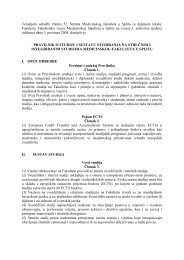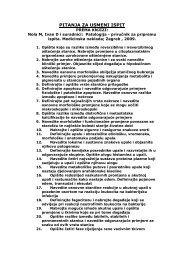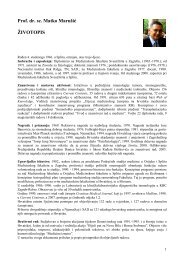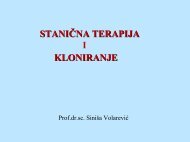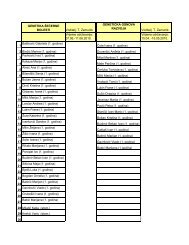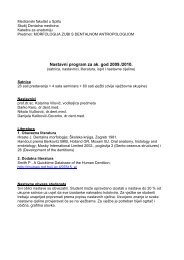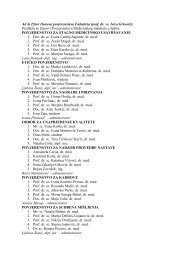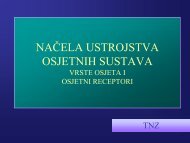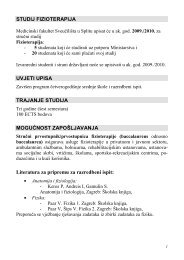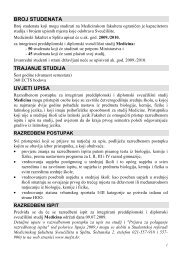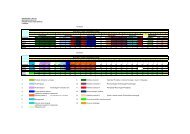Stem Cells: Review A New Lease on Life
Stem Cells: Review A New Lease on Life
Stem Cells: Review A New Lease on Life
Create successful ePaper yourself
Turn your PDF publications into a flip-book with our unique Google optimized e-Paper software.
Cell, Vol. 100, 143–155, January 7, 2000, Copyright ©2000 by Cell Press<str<strong>on</strong>g>Stem</str<strong>on</strong>g> <str<strong>on</strong>g>Cells</str<strong>on</strong>g>:A <str<strong>on</strong>g>New</str<strong>on</strong>g> <str<strong>on</strong>g>Lease</str<strong>on</strong>g> <strong>on</strong> <strong>Life</strong><str<strong>on</strong>g>Review</str<strong>on</strong>g>Elaine Fuchs* and Julia A. SegreHoward Hughes Medical InstituteDepartment of Molecular Genetics and Cell BiologyDepartment of Biochemistry and Molecular Biologysuccessful parallels with human tissue, cells from theinner cell mass (ICM) of mammalian blastocysts can bemaintained in tissue culture under c<strong>on</strong>diti<strong>on</strong>s where theycan be propagated indefinitely as pluripotent embry<strong>on</strong>icThe University of Chicagostem (ES) cells (Thoms<strong>on</strong> et al., 1998 and referencesChicago, Illinois 60637therein). If injected back into a recipient blastocyst thatis then carried to term in a female host, these cellscan c<strong>on</strong>tribute to virtually all the tissues of the chimericDuring embryogenesis, a single fertilized oocyte gives offspring, including the germ cell compartment. Torise to a multicellular organism whose cells and tissues maintain cultured ES cells in their relatively undifferentihaveadopted differentiated characteristics or fates to ated, pluripotent state, they must both express the inperformthe specified functi<strong>on</strong>s of each organ of the trinsic transcripti<strong>on</strong> factor Oct4, and c<strong>on</strong>stitutively re-body. As embryos develop, cells that have acquired their ceive the extrinsic signal from the cytokine leukemiaparticular fate proliferate, enabling tissues and organs inhibitory factor (LIF) (Nichols et al., 1998; Niwa et al.,to grow. Even after an animal is fully grown, however, 1998 and references therein).many tissues and organs maintain a process known as Up<strong>on</strong> LIF withdrawal, cultured ES cells sp<strong>on</strong>taneouslyhomeostasis, where as cells die, either by natural death aggregate into embryo-like bodies, where they differen-or by injury, they are replenished. This remarkable feature tiate and spawn many cell lineages, including beatinghas ancient origins, dating back to the most primitive heart muscle cells, blood islands, neur<strong>on</strong>s, pigmentedanimals, such as sp<strong>on</strong>ges and hydrozoans. Throughout cells, macrophages, epithelia, and fat-producing adipo-evoluti<strong>on</strong>, nature has exerted c<strong>on</strong>siderable fun and fancy cytes (Figure 1; for review, see Bradley, 1990). Similarly,in elaborating <strong>on</strong> this theme. Some amphibians, for intiatewhen ES cells are injected into nude mice, they differen-stance, can regenerate a limb or tail when severed, andinto multicellular masses, called teratocarcinomas.the neur<strong>on</strong>s of bird brains can readily regenerate. While Although the programs of gene expressi<strong>on</strong> in thesemammals seem to have lost at least some of this w<strong>on</strong>entiati<strong>on</strong>structures often bear str<strong>on</strong>g resemblance to the differ-derful plasticity, their liver can partially regenerate protriggeringpathways typical of developing animals, theof these programs is chaotic, yielding a jumvidingthat the injury is not too severe, and the epidermisand hair of their skin can readily repair when wounded bled grab bag of tissue types. These examples graphi-or cut. Additi<strong>on</strong>ally, the epidermis, hair, small intestine, cally illustrate the importance of intercellular interacti<strong>on</strong>sand hematopoietic system are all examples of adult tisandembryo shape.and cellular organizati<strong>on</strong> in orchestrating developmentsues that are naturally in a state of dynamic flux: evenin the absence of injury, these structures c<strong>on</strong>tinually giveDuring development, intercellular cross-talk results inrise to new cells, able to transiently divide, terminallythe generati<strong>on</strong> and transmissi<strong>on</strong> of specific signals froma cell to its neighbor, altering in some key way the subsedifferentiateand die.quent behavior of the neighbor. Of prime importance isThe fabulous ability of an embryo to diversify and ofsifting through the galaxy of envir<strong>on</strong>mental signals tocertain adult tissues to regenerate throughout life is adetermine which c<strong>on</strong>stellati<strong>on</strong>s of cues can selectivelydirect result of stem cells, nature’s gift to multicellularcoax ES cells down a specific cell lineage pathway atorganisms. <str<strong>on</strong>g>Stem</str<strong>on</strong>g> cells have both the capacity to selftheexpense of all others. To this end, Brüstle et al.renew, that is, to divide and create additi<strong>on</strong>al stem cells,(1999) were recently able to obtain pure populati<strong>on</strong>s ofand also to differentiate al<strong>on</strong>g a specified molecularmultipotent progenitor cells expressing glial precursorpathway. Embry<strong>on</strong>ic stem cells are very nearly totipomarkers.They achieved this goal by taking aggregatestent, reserving the elite privileges of choosing am<strong>on</strong>gof cultured mouse ES cells and propagating them semostif not all of the differentiati<strong>on</strong> pathways that specifyquentially in medium c<strong>on</strong>taining first fibroblast growththe animal. In c<strong>on</strong>trast, stem cells that reside within anfactor (FGF) 2 al<strong>on</strong>e, then a mixture of FGF2 and epideradultorgan or tissue have more restricted opti<strong>on</strong>s, oftenmal growth factor (EGF), and finally a mix of FGF2 andable to select a differentiati<strong>on</strong> program from <strong>on</strong>ly a fewplatelet-derived growth factor (PDGF). Bathed in thispossible pathways. Or so it seemed, until very recently.last broth of growth factors, these pluripotent cells couldIn the last year, some spectacular fireworks have ex- be maintained for many generati<strong>on</strong>s in culture. Up<strong>on</strong>ploded many l<strong>on</strong>g-standing dogmas in the stem cell growth factor withdrawal, they subsequently differentiworld,giving adult stem cells a new lease <strong>on</strong> life, and en- ated into either of two specific lineages, oligodendroablingthem to be what researchers previously thought cytes or astrocytes (Brüstle et al., 1999).they were not.Illustrating the enormous potential of this type of researchfor clinical applicati<strong>on</strong>, McKay and coworkersEmbry<strong>on</strong>ic <str<strong>on</strong>g>Stem</str<strong>on</strong>g> <str<strong>on</strong>g>Cells</str<strong>on</strong>g>transplanted these cl<strong>on</strong>ed glial precursor cells into theEmanating from the pi<strong>on</strong>eering mouse research of Mar- ventricle of myelin-deficient rats. Myelin sheaths formedtin Evans in the 1970s and culminating with the recent around host ax<strong>on</strong>s in various brain regi<strong>on</strong>s, includingcortex, hippocampus, and hypothalamus (Figure 2;* To whom corresp<strong>on</strong>dence should be addressed (e-mail: liptack@midway.uchicago.edu).Brüstle et al., 1999). No signs of n<strong>on</strong>neur<strong>on</strong>al tissue weredetected in the transplants. The use of pure populati<strong>on</strong>s
Cell144Figure 2. Developmental Potential of ES <str<strong>on</strong>g>Cells</str<strong>on</strong>g> In VivoFrame shows myelin repair by ES cell transplantati<strong>on</strong>. ES cell–derived glial precursors grafted into the ventricle of myelin-deficientrats generate oligodendrocytes and astrocytes in multiple host brainregi<strong>on</strong>s. D<strong>on</strong>or cells are identified by mouse-specific DNA in situhybridizati<strong>on</strong> (purple nuclear labeling) and double labeling with antibodiesto myelin proteolipid protein (green), produced by the ESderivedcells. (Courtesy of Oliver Brüstle; see also Brüstle et al.,1999.)in our understanding of how various cell fates becomedetermined as embryos develop. The identificati<strong>on</strong> ofintrinsic markers—e.g., transcripti<strong>on</strong> factors, essentialfor the specificati<strong>on</strong> of a differentiati<strong>on</strong> pathway and/ororgan—has provided molecular tools for further exploringhow cell fate commitments are systematically made(for reviews, see Firulli and Ols<strong>on</strong>, 1997; Orkin and Z<strong>on</strong>,1997; Orkin, 1998; Edlund and Jessell, 1999).While diversificati<strong>on</strong> of cell types is largely completeat or shortly after birth, many tissues in the adult undergoself renewal and accordingly must establish a life-l<strong>on</strong>gpopulati<strong>on</strong> of relatively pliable stem cells. Adult stemcells are often relatively slow-cycling cells able to re-sp<strong>on</strong>d to specific envir<strong>on</strong>mental signals and either gen-erate new stem cells or select a particular differentiati<strong>on</strong>program (Figure 3). When a stem cell undergoes a com-mitment to differentiate, it often first enters a transientstate of rapid proliferati<strong>on</strong>. Up<strong>on</strong> exhausti<strong>on</strong> of its prolif-erative potential, the transiently amplifying cell with-draws from its cycle and executes its terminal differenti-ati<strong>on</strong> program (Potten et al., 1979). Adult stem cellsare often localized to specific niches, where they utilizemany but not necessarily all, of the external and intrinsiccues used by their embry<strong>on</strong>ic counterparts in selectinga specific fate. Locating and analyzing stem cell nichesand elucidating the molecules that orchestrate specificdevelopmental programs are important steps in de-termining the key comp<strong>on</strong>ents of the envir<strong>on</strong>ment thatlegislate differentiati<strong>on</strong> commitments and stem cell reg-ulati<strong>on</strong>.Figure 1. Differentiati<strong>on</strong> Potential of Embry<strong>on</strong>ic <str<strong>on</strong>g>Stem</str<strong>on</strong>g> (ES) <str<strong>on</strong>g>Cells</str<strong>on</strong>g>ES cells are isolated from the ICM (inner cell mass) of a blastocyst,cultured, and then differentiated as embryoid bodies. Given theproper combinati<strong>on</strong> of growth factors, these embryoid bodies candevelop into such diverse cell types as adipocytes, erythrocytes,macrophages, vascular smooth muscle cells (VSMC), oligodendro-cytes, or astrocytes (see Keller et al., 1993; Dani et al., 1997; Drabet al., 1997; Brüstle et al., 1999). RA, retinoic acid; T 3 , triiodothyr<strong>on</strong>ine;Epo, erythroprotein; M-CSF, macrophage col<strong>on</strong>y stimulatingfactor; IL, interleukin; db-CAMP, dibutyryl cyctic AMP; FGF, fibroblastgrowth factor; EGF, epidermal growth factor; PDGF, plateletderivedgrowth factor.of ES-derived glial precursor cells to repair the nervoussystem of a genetically defective rodent has direct implicati<strong>on</strong>sfor the treatment of Pelizaeus-Marzbacher disease(PMD), a hereditary human myelin disorder. Morebroadly, the research holds promise for the future useof other ES-derived, lineage-restricted precursor populati<strong>on</strong>sin the treatment of various human disorderswhere the loss or degenerati<strong>on</strong> of a particular cell typethreatens body functi<strong>on</strong>.With more than 2,000 growth factors purified and/orcl<strong>on</strong>ed at the close of the millenium, the ability to employgrowth factor supplements to direct ES cells down specificlineage pathways seems <strong>on</strong> the <strong>on</strong>e hand endlessand <strong>on</strong> the other, hopelessly complex. While the nuancesof obtaining pure ES-derived cl<strong>on</strong>al precursorcells are still poorly understood, headway has beenmade in determining which extrinsic factors govern certainother lineages. As new clues are obtained fromadditi<strong>on</strong>al developmental and cell culture studies, anunderstanding of how human ES cells choose other specificpathways of differentiati<strong>on</strong> will c<strong>on</strong>tinue to providepivotal groundwork for future clinical applicati<strong>on</strong>s ofstem cell technology.The Existence of Adult <str<strong>on</strong>g>Stem</str<strong>on</strong>g> <str<strong>on</strong>g>Cells</str<strong>on</strong>g> and Their NichesIdentifying the signals that regulate stem cell differentiati<strong>on</strong>is fundamental to understanding cellular diversity.In recent years, tremendous advances have been madeFigure 3. <str<strong>on</strong>g>Stem</str<strong>on</strong>g> <str<strong>on</strong>g>Cells</str<strong>on</strong>g> Self-Renew and Differentiate to Give Rise toTransit Amplifying and Fully Differentiated <str<strong>on</strong>g>Cells</str<strong>on</strong>g>
<str<strong>on</strong>g>Review</str<strong>on</strong>g>145Figure 4. <str<strong>on</strong>g>Stem</str<strong>on</strong>g> <str<strong>on</strong>g>Cells</str<strong>on</strong>g> Develop and Maintain Their Ability to Self-Renew within a Specific NicheShown are the stem cell niches for (A) epidermis in n<strong>on</strong>haired skin (the tip of the undulati<strong>on</strong>s within the basal layer); (B) hair follicle andepidermis (the bulge); (C) small intestine (the crypt cells); (D) neural cell precursors (either the ependymal or the subventricular z<strong>on</strong>e cells);(E) the hematopoietic system (HSCs; in the b<strong>on</strong>e marrow). V, ventricular z<strong>on</strong>e; SVC, subventricular z<strong>on</strong>e; E, ependymal; OB, olfactory bulb;HSC, hematopoietic stem cell; A, adipocyte; M, megakayocyte; T-L, T lymphocyte; B-L, B lymphocyte; B, basophil; E, eosinophil (in panel[E]); N, neutrophil; Er, erythrocyte; S, stromal cell; V, vein; Art, artery.Some stem cells of adult mammals d<strong>on</strong>’t seem to The hair follicle is composed of an outer root sheathhave a specified niche within their respective tissue. (ORS) that is c<strong>on</strong>tiguous with the epidermis, an innerThus, for example, skeletal muscles are renewed primar- root sheath (IRS), and the hair shaft itself (Figure 4B).ily up<strong>on</strong> injury, when quiescent satellite myoblasts The actively dividing cells that give rise to the IRS andattached to muscle fiber bundles become reactivated, hair shaft are called matrix cells, a transiently dividingproliferating transiently and then fusing to form the differentiatedpopulati<strong>on</strong> of epithelial cells in the follicle bulb that en-myotubes necessary to repair damaged fi- gulf a pocket of specialized mesenchymal cells, calledbers (for review, see Miller et al., 1999). In other cases, the dermal papilla. In the adult hair follicle, the lowerhowever, a stem cell compartment is established within segment undergoes periods of active growth (anagen)a developing tissue, and cells within this niche are then and destructi<strong>on</strong> (catagen/telogen) (Figure 4B; for review,activated in resp<strong>on</strong>se to specific envir<strong>on</strong>mental cues. see Hardy, 1992). As matrix cells exhaust their proliferativeFigure 4 illustrates five different examples of stem cellcapacity, the follicle regresses, dragging the pocketcompartments that reside within adult tissues.of dermal papilla cells up to the permanent epithelialSelf-Renewing Epithelial <str<strong>on</strong>g>Stem</str<strong>on</strong>g> Cell Nichesporti<strong>on</strong> of the follicle, called the bulge, which is theEpidermis and Hair Follicles. A prime example of a tissue putative home of follicle stem cells (for review, seethat must undergo c<strong>on</strong>tinual and rapid self-renewal is Lavker et al., 1991). In resp<strong>on</strong>se to a stimulus from thethe epidermis and its notable appendage, the hair folli- dermal papilla, <strong>on</strong>e or more stem cells in the bulge commitcle. Derived from a comm<strong>on</strong> embry<strong>on</strong>ic origin and locatedto regenerating the follicle. These stem cells canat the skin surface, mammalian epidermis and also generate epidermis, and up<strong>on</strong> wounding or burnhair follicles are naturally exposed to ultraviolet radiati<strong>on</strong> injury, cells from this regi<strong>on</strong> of the follicle reepithelializeand other physical and chemical assaults, necessitating the damaged epidermis (Green, 1991).a mechanism for self-renewal as well as for protecting Given nature’s desire to tuck stem cells away fromthe stem cell compartment(s). The epidermis does so harm’s way, the bulge would seem to be the ideal nicheby maintaining a single inner (basal) layer of dividing to harbor both epidermal and follicle stem cells, andcells, which periodically withdraw from the cell cycle, experimental evidence in favor of this hypothesis c<strong>on</strong>tinuescommit to differentiate terminally, and move outwardto accumulate. Thus for example, bulge cells havetoward the skin surface (Figure 4A). Terminally differenti- a l<strong>on</strong>g cell cycle, as illustrated by the fact that thisated cells that reach the skin surface are sloughed, c<strong>on</strong>tinuallycompartment is the residence of the majority of label-being replaced by inner cells differentiating and retaining skin cells (65%) in mice given a pulse ofmoving outward. Since human epidermis turns over everytritiated thymidine (Cotsarelis et al., 1990; Kobayashi ettwo weeks, and since each transiently amplifying al., 1993; Morris and Potten, 1994). The bulge also yieldsbasal cell divides <strong>on</strong>ly 3–6 times before it differentiates, the best outgrowth of hair follicle keratinocytes in culturethe self-renewing capacity of epidermal stem cells isenormous.(Kobayashi et al., 1993; Yang et al., 1993), and when bulgecells are combined with dermal papilla cells, they can
Cell146rec<strong>on</strong>stitute a viable hair follicle (Oliver, 1966). All ofthese data lend further support for the bulge as a primestem cell niche. This said, at least in human skin, somestem cells are also likely to reside in the epidermal basallayer (J<strong>on</strong>es et al., 1995).Intestinal Epithelium. The small intestine is composedof ciliated villi, each surrounded by crypts, embeddedin the intestinal wall for protecti<strong>on</strong> (Figure 4C). Eachcrypt is composed of about 250 simple epithelial cellsthat include the stem cell compartment for replenishingthe villi. The multipotent stem cells are located near or atthe base of each crypt (Loeffler et al., 1993). To maintainhomeostasis, slow cycling stem cells are c<strong>on</strong>verted torapidly but transiently proliferating cells that move tothe midsegment and subsequently differentiate into eitherthe absorptive brush-border enterocytes, mucussecretinggoblet cells, or enteroendocrine cells of thevilli. The differentiated cells eventually die and are shedfrom the villi into the lumen of the gut. Crypt stem cellsalso produce Paneth cells at the base of the crypt, whichsynthesize and secrete antimicrobial peptides, digestiveenzymes, and growth factors. These cells are eventuallycleared from the crypt by phagocytosis.The ability to select am<strong>on</strong>g multiple terminal differentiati<strong>on</strong>pathways and to generate differentiating cells thatcan either migrate upward or downward are characteristicsthat parallel those of the hair follicle bulge. Moreover,like the hair follicle stem cells, stem cells of thesmall intestine rely up<strong>on</strong> mesenchymal cues for theirsurvival and differentiati<strong>on</strong>.Multipotent Neural <str<strong>on</strong>g>Stem</str<strong>on</strong>g> <str<strong>on</strong>g>Cells</str<strong>on</strong>g> in the Brain. The diversificati<strong>on</strong>of cell types in biology reaches its extreme withthe vertebrate nervous system. During embryogenesis,neural progenitor cells develop in the neural crest (LeDouarin, 1986). These multipotent versatile cells detachfrom the dorsolateral margins of the neural tube andmigrate to specified sites throughout the developingembryo, where they differentiate into neur<strong>on</strong>s and glia ofthe peripheral nervous system, as well as melanocytes,smooth muscle cells, facial b<strong>on</strong>es, and cartilage. Theparticular fate of a neural crest cell is influenced by localcues, which are likely to be transmitted in part by thedorsal neural tube and in part by the migrati<strong>on</strong> pathfated by the cell (for review, see Le Douarin et al., 1993;Edlund and Jessell, 1999).To assess the multipotency of individual neur<strong>on</strong>alcells and their potential for self-renewal, cultures havebeen made from embry<strong>on</strong>ic neural crest or fetal neur<strong>on</strong>altissue (for review, see Anders<strong>on</strong> et al., 1997). Culturedquail neural crest cells permit the preferential expansi<strong>on</strong>of melanocytic and glial lineages when exposed to thegrowth factor endothelin 3 (Lahav et al., 1998), and cl<strong>on</strong>alpopulati<strong>on</strong>s derived from neural crest or embry<strong>on</strong>ic ratsciatic nerve give rise to neur<strong>on</strong>s, Schwann cells andsmooth muscle-like fibroblasts in culture (Morris<strong>on</strong> etal., 1999). If cultured rat neural crest cells are then in-jected into early host chick embryos, they migrate correctlyand col<strong>on</strong>ize the neural crest derivatives appropri-ately (Morris<strong>on</strong> et al., 1999; White and Anders<strong>on</strong>, 1999;Figure 5). While these neural progenitor cells have arather modest ability to proliferate (6–10 generati<strong>on</strong>s),their multipotency c<strong>on</strong>firms the existence of “stem cell–like” progenitors in the developing nervous system.Multipotent neural progenitors have also been found inFigure 5. Cultured Rat Neural Crest <str<strong>on</strong>g>Cells</str<strong>on</strong>g> Injected into Early ChickEmbryos Migrate Correctly and Col<strong>on</strong>ize the Neural Crest Deriva-tivesStained cells are positive for the panneur<strong>on</strong>al marker SCG10; ratneur<strong>on</strong>s are in purple and chicken neur<strong>on</strong>s are in orange.(A) Remak’s ganglia from a chicken that as an embryo was injectedat the sacral axial level with sciatic nerve stem cells.(B) Peripheral nerve of a chicken injected with sciatic nerve stemcells.(C) Pelvis parasympathetic plexus of a chicken injected with migra-tory neural crest cells. (Courtesy of Pamela White and David Ander-s<strong>on</strong>; see also Morris<strong>on</strong> et al., 1999; White and Anders<strong>on</strong>, 1999.)the embry<strong>on</strong>ic CNS and forebrain, and similar graftingstudies indicate that even human embry<strong>on</strong>ic brain cellscan divide, migrate, and populate the major areas ofrecipient rodent brains (Johe et al., 1996; Brüstle et al.,1998; Flax et al., 1998).Mammalian brain develops as a tube c<strong>on</strong>taining aventricular compartment filled with cerebral fluid. Divid-ing, uncommitted neural crest–derived cells reside ini-tially in the luminal cell layer, or ventricular z<strong>on</strong>e, andthen as development proceeds, in the “subventricularz<strong>on</strong>e” that forms beneath it. In development, these cellsgive rise to astrocytes, oligodendrocytes, and the neu-r<strong>on</strong>s that populate the olfactory bulb. Building up<strong>on</strong>these developmental clues, Reynolds and Weiss (1992)isolated the nerve tissue beneath the lateral ventriclesof adult mouse brain, and after enzymatic dissociati<strong>on</strong>,cultured the cells from the tissue. When induced to pro-liferate in vitro by epidermal growth factor, some of thecultured cells initially expressed nestin, composing theintermediate filaments (IFs) of neuroepithelial stem cells(Fuchs and Weber, 1994). These cultures subsequentlyaggregated into structures referred to as neurospheres,which sp<strong>on</strong>taneously differentiated into a mixture of astro-cytes, oligodendrocytes, and neurotransmitter-expressingneur<strong>on</strong>s.The cl<strong>on</strong>ogenicity of neurospheres, and their abilityto give rise to multiple neural cell types provides str<strong>on</strong>gevidence that somewhere within the ventricular/subventricularz<strong>on</strong>e of the adult mammalian brain lurks amultipotent stem cell compartment (Figure 4D). Re-searchers have c<strong>on</strong>tinued to h<strong>on</strong>e in <strong>on</strong> this locati<strong>on</strong> asa niche for multipotent, adult brain stem cells. Since the
<str<strong>on</strong>g>Review</str<strong>on</strong>g>147The Biochemical Properties of <str<strong>on</strong>g>Stem</str<strong>on</strong>g> <str<strong>on</strong>g>Cells</str<strong>on</strong>g>:Just How Primitive Is a <str<strong>on</strong>g>Stem</str<strong>on</strong>g> Cell?A classic percepti<strong>on</strong> of stem cells is that they are undifferentiatedcells, making them pliable to adopt variousdifferent cell fates. Perhaps more than any other featureattributed to stem cells, this has misled biologists intopeering into the wr<strong>on</strong>g niches and ignoring the rightniches in search of stem cells. The realizati<strong>on</strong> that stemcells can masquerade behind morphological and biochemicalfeatures normally attributed to differentiatedcell types has revoluti<strong>on</strong>ized our view of what stem cellslook like and where to find them.Skin <str<strong>on</strong>g>Stem</str<strong>on</strong>g> <str<strong>on</strong>g>Cells</str<strong>on</strong>g>: Really a Keratinocyte After All,but One with Some Unique BiochemistryThe biochemical hallmark of keratinocytes is expressi<strong>on</strong>of K5 and K14, keratins that produce elaborate interme-diate filament (IF) networks in these cells (for review, seeFuchs and Weber, 1994). Whereas transiently amplifyingmatrix cells are largely devoid of keratin IFs, bulge stemcells possess a K5 and K14 IF network; these keratinsare even more abundant in basal epidermal and upperORS cells (Figure 6A; Coulombe et al., 1989; Vasioukhinet al., 1999). If a single populati<strong>on</strong> of bulge stem cellsgives rise to matrix, epidermis, and ORS, as is presentlythought, then these stem cells must downregulate,upregulate, and not change keratin expressi<strong>on</strong>, respec-tively, in choosing am<strong>on</strong>g these pathways.Expressi<strong>on</strong> of keratins 5 and 14 defines bulge stemcells as keratinocytes. In vitro, a single human folliclestem cell can generate as many as 1.7 10 38 progenyin culture, far more than necessary to cover an adulthuman (Rheinwald and Green, 1975; Rochat et al., 1994).By studying those cultured keratinocytes that have highproliferative capacity, researchers have been able todefine additi<strong>on</strong>al biochemical properties of these cells(J<strong>on</strong>es et al., 1995; for review see Watt, 1998; Li et al.,1998 and references therein). These include elevatedlevels of cell surface integrins, and the ability to adhererapidly to type IV collagen (21 receptor) and fibr<strong>on</strong>ectin(51 receptor). As judged by immunofluorescence,these cells also appear to have reduced levels of theintercellular juncti<strong>on</strong> protein, E-cadherin (Moles andWatt, 1997). Taken together, these findings predict thatkeratinocyte stem cells in vivo are likely to adherestr<strong>on</strong>gly to their extracellular matrix-rich basementmembrane, perhaps keeping them in their niche, andyet be less adhesive to <strong>on</strong>e another, enabling an individualstem cell to be rapidly mobilized and exit from itsniche. The integrins and cadherins <strong>on</strong> the surface ofkeratinocytes not <strong>on</strong>ly play a role in cell adhesi<strong>on</strong>, but inadditi<strong>on</strong> activate signal transducti<strong>on</strong> pathways essentialfor their proliferati<strong>on</strong> and survival (see Watt, 1998).Still in its infancy is the topic of how keratinocytestem cells resp<strong>on</strong>d to external cues and commit to theirvarious lineages. Recent evidence suggests that Wnt orequivalent signals may be involved. The product of Wntsignaling is the accumulati<strong>on</strong> of -catenin, a protein thatnormally interacts with E-cadherin to promote intercellu-lar adhesi<strong>on</strong> (for reviews, see Gumbiner, 1997; Nusse,1999). When rapid turnover of -catenin is prevented byWnt signaling, excess -catenin is free to interact withavailable members of the Lef/Tcf family of DNA-bindingproteins, producing a transcripti<strong>on</strong> complex able to activatedownstream target genes, including c-myc andidentificati<strong>on</strong> of these stem cells is dependent up<strong>on</strong>biochemistry, we will discuss this in more detail in thenext secti<strong>on</strong>.Finding a Niche for Hematopoietic <str<strong>on</strong>g>Stem</str<strong>on</strong>g> <str<strong>on</strong>g>Cells</str<strong>on</strong>g>. Selfrenewalis essential in the hematopoietic system as welose and replace over a billi<strong>on</strong> red blood cells every day.Many of the c<strong>on</strong>cepts and generalizati<strong>on</strong>s about stemcells come from studies of multipotent hematopoieticstem cells (HSCs). Through a step-wise series of extrinsicand intrinsic cues, many of them elucidated, HSCsdifferentiate to give rise to progenitor cells with progressivelymore limited opti<strong>on</strong>s (see Weissman, 2000 [thisissue of Cell]). HSCs give rise to lymphoid progenitorcells that can in turn differentiate into T and B lymphocytes,and HSCs can also give rise to myeloid progenitorcells that can produce basophils, eosinophils, neutrophils,macrophages, platelets, and erythrocytes (Figure4E).During development in mammals, the first blood cells,called embry<strong>on</strong>ic nucleated erythrocytes, appear in theextraembry<strong>on</strong>ic yolk sac and express certain transcripti<strong>on</strong>factors that specify these cells to their hematopoieticfate (Robb et al., 1995; Shivdasani et al., 1995).In the developing embryo itself, mesodermally derivedprecursor cells migrate into an envir<strong>on</strong>ment permissivefor hematopoiesis that is located in the aorta, genitalridge (g<strong>on</strong>ad), and mes<strong>on</strong>ephros (AGM) regi<strong>on</strong> (Medvinskyand Dzierzak, 1996). Based <strong>on</strong> (a) the phenotype ofmice lacking vascular endothelial growth factor (VEGF)or its tyrosine kinase receptor, Flk1, and (b) complementaryin vitro studies with Flk-1 null ES cells, the VEGF-Flk-1 (and VEGFR2) signal transducti<strong>on</strong> pathway appearsto be essential in regulating the migrati<strong>on</strong> ofembry<strong>on</strong>ic blood cell and endothelial progenitors to theAGM (Asahara et al., 1997; Hidaka et al., 1999; Ziegleret al., 1999; Schuh et al., 1999 and references therein).As development progresses, HSCs migrate to the fetalliver, a process that relies heavily <strong>on</strong> 1 integrin. Thisintegrin partners with several subunits <strong>on</strong> the HSCsurface, reacts to envir<strong>on</strong>mental cues and governs theexpressi<strong>on</strong> of new intrinsic factors (Hirsch et al., 1996;for review, see Orkin and Z<strong>on</strong>, 1997). While in residencein the fetal liver, some HSCs can differentiate to giverise to more restricted progenitor cells for both the myeloidand lymphoid lineages. Just before birth, HSCsrelocate to the b<strong>on</strong>e marrow, where blood formati<strong>on</strong> ismaintained throughout the lifetime of the animal (Figure4E).HSCs differ from epithelial and embry<strong>on</strong>ic stem cellsin that they do not adhere tightly to <strong>on</strong>e another. Thismay explain why they seem to have a hard time settlingdown to a particular niche. Even in the adult, populati<strong>on</strong>sof stem cells and their progeny with more restrictedpotential are detectable in peripheral blood, spleen, andliver, as well as in b<strong>on</strong>e marrow. Tracking experimentshave shown that HSCs are mobile, and like young adults,periodically come home after their travels away fromthe niche. Like epithelial and embry<strong>on</strong>ic stem cells, thehematopoietic system relies heavily <strong>on</strong> homeostasis inthe adult. In this case, however, HSC homing as well asthe c<strong>on</strong>versi<strong>on</strong> of HSCs to more limited multiprogenitorcells become key, and as discussed later, these processesdepend up<strong>on</strong> external cues provided by the b<strong>on</strong>emarrow niche.
Cell148cyclin D1 (He et al., 1998; Tetsu and McCormick, 1999).In this way, -catenin could be a key intermediary betweenweakening the niches’ hold <strong>on</strong> a stem cell andenabling it to activate proliferati<strong>on</strong> and differentiati<strong>on</strong>.Cultured keratinocyte stem cells have elevated levelsof activated -catenin (Zhu et al., 1999), and folliclebulge cells express Tcf3, a member of the Lef/Tcf family(Figure 6A; DasGupta and Fuchs, 1999). Moreover, whenstabilized -catenin is expressed in transgenic mice underthe c<strong>on</strong>trol of the K14 promoter, follicle cells in thebulge can be activated to express Tcf/Lef/-catenin targetgenes, and interfollicular epidermis can be induced toform de novo hair follicles, normally a property of pluripotentembry<strong>on</strong>ic ectoderm (Gat et al., 1998; DasGupta andFuchs, 1999). Interestingly, a cousin of Tcf3, Lef1 seemsto be important for early follicle develoment and for thelater stages of hair follicle differentiati<strong>on</strong> (van Genderenet al., 1994; Zhou et al., 1995). The precise molecularpathways involved and the external cues regulating theseprocesses are complex and remain largely unknown.Intestinal <str<strong>on</strong>g>Stem</str<strong>on</strong>g> <str<strong>on</strong>g>Cells</str<strong>on</strong>g> of the Crypt: Characteristicsof Epithelial <str<strong>on</strong>g>Cells</str<strong>on</strong>g> and Expressi<strong>on</strong> of TcfFamily MembersDespite their well-defined niche, intestinal stem cellshave been difficult to culture, and hence, much of whathas been learned about the biochemistry of intestinalstem cells comes from studying tumorigenesis (for review,see Stappenbeck et al., 1998). This field beganwith the cl<strong>on</strong>ing of the gene whose defect is resp<strong>on</strong>siblefor familial adematous polyposis coli (APC), or col<strong>on</strong>polyps, and expanded with the realizati<strong>on</strong> that in itsfuncti<strong>on</strong>al form, APC physically interacts with -cateninand accelerates its degradati<strong>on</strong> through the ubiquitinmediatedproteosome system (for reviews, see Gumbiner,1997; Nusse, 1999). This led so<strong>on</strong> to the discoveryof the intestinal-specific Lef/Tcf family member, Tcf4,which resides within the crypt (Figure 6B). Subsequentfuncti<strong>on</strong>al analysis revealed that Tcf4 null mutati<strong>on</strong>s inmice obliterate the stem cell compartment of the intestinalcrypt (Korinek et al., 1998). These findings are reminiscentof those more recently obtained for skin, andprovide the best evidence to date that Lef/Tcf--catenincomplexes may be important intrinsic factors that c<strong>on</strong>trolmaintenance of and/or exit from epithelial stem cellcompartments.While many of the features that govern the behavior ofintestinal stem cells remain unknown, comm<strong>on</strong> themesc<strong>on</strong>tinue to surface am<strong>on</strong>g epithelial stem cell compartments.Thus, integrins and their extracellular matrix ligandsappear to be important for stem cell maintenanceand/or homeostasis in the crypt, and crypt stem cellsexpress IFs, in this case, the simple epithelial keratins,K8, K18, and K19 (Beaulieu, 1992; Potten et al., 1997).Intriguingly, col<strong>on</strong> hyperplasia is seen in the large intestineof mice lacking K8 (Baribault et al., 1994), suggestingthat changes in keratin levels may influence proliferati<strong>on</strong>Figure 6. <str<strong>on</strong>g>Stem</str<strong>on</strong>g> <str<strong>on</strong>g>Cells</str<strong>on</strong>g> Display Characteristic Biochemical Markers of Tcf4 (brown); higher intensity in the crypt, denoted by arrows.(A) <str<strong>on</strong>g>Stem</str<strong>on</strong>g> cells of a mouse hair follicle bulge show expressi<strong>on</strong> of Tcf3 (Courtesy of Hans Clevers; see also Korinek et al., 1998.)(green). (Courtesy of Ramanuj DasGupta and Elaine Fuchs; see also (C) Glial-derived alkaline phosphatase–positive (AP, purple) neur<strong>on</strong>sDasGupta and Fuchs, 1999.) (see text) migrating en route to the olfactory bulb. (Courtesy of F.(B) Crypt stem cells of mouse embry<strong>on</strong>ic intestine shows expressi<strong>on</strong> Doetch and A. Alvarez-Buylla; see also Doetsch et al., 1999.)
<str<strong>on</strong>g>Review</str<strong>on</strong>g>149and/or migrati<strong>on</strong>, properties that are important for c<strong>on</strong>- case, ependymal cells are unusual glial cells in that theytrolling homeostasis in the intestinal crypt. Intercellular express Notch 1 receptors, nestin, and other neur<strong>on</strong>aladhesi<strong>on</strong> is also involved in crypt homeostasis, and cell markers, as well as markers such as GFAP, typicaloverexpressi<strong>on</strong> of intestinal Ecadherin in mice suppressesof glial cells. Thus, it could be that these neural stemproliferati<strong>on</strong> and induces apoptosis in the crypt, cells are Jekyll and Hydes, possessing multiple differen-slowing cell movement up the villus (Hermist<strong>on</strong> et al., tiati<strong>on</strong> markers that they can suppress or enhance de-1996). One feature of the intestine, seemingly less impor- pending up<strong>on</strong> the fate they become committed to.tant in the epidermis and hair follicle, is the regulati<strong>on</strong> Properties of HSCs and Their Progeny.of intestinal cell number by apoptosis (for review, see How Primitive Are HSCs After All?Potten et al., 1997). Overall, however, the stem cells of By an order of magnitude, the molecular pathways ofthe intestine, like their skin counterparts, possess quite hematopoiesis are the most thoroughly explored of allmarked biochemical features that classify them as epithelialstem cell systems. The cytokine requirements, tran-cells, rather than primitive cells bearing little or scripti<strong>on</strong>al regulators, and cell surface features neces-no resemblance to their neighbors.sary for hematopoietic stem cells to interact with theirMultipotent Neur<strong>on</strong>al <str<strong>on</strong>g>Stem</str<strong>on</strong>g> <str<strong>on</strong>g>Cells</str<strong>on</strong>g>: A Glial Cellniches are quite well defined, as are the molecular distincti<strong>on</strong>sAfter All?between hematopoietic stem cells and theirTwo groups have recently purified the multipotential progenitors (for reviews, see Orkin, 1998; Glimcher andcells in nerve tissue from adult mouse brain (Doetsch Singh, 1999; Weissman, 2000). Until recently, theseet al., 1999; Johanss<strong>on</strong> et al., 1999). The groups differ studies had pointed to a model whereby biochemicallyin their view of whether these progenitors are ependymal naive pluripotent stem cells, exposed to various cyto-cells that line the luminal surface of the adult ventricular kines, progressively acquire specific intrinsic factorsz<strong>on</strong>e (Johanss<strong>on</strong> et al., 1999), or astrocytes that reside and differentiate to generate a hierarchy of progenitors.in the subventricular z<strong>on</strong>e just beneath it (Doetsch et In the early stages of differentiati<strong>on</strong>, these progenitorsal., 1999). However, both groups seem to have isolated are themselves stem cells, but are more restricted insimilar cells, which are relatively well-differentiated, cili- their opti<strong>on</strong>s than their parent stem cells (Figure 7).ated cells able to push the cerebral spinal fluid through To some extent, this deterministic model, parallelingthe ventricles, and also able to divide and give rise to models of myogenesis (Firulli and Ols<strong>on</strong>, 1997), worksboth neur<strong>on</strong>s and glial cells in culture. To provide direct well to explain many of the key features of hematopoieticevidence that a glial-like stem cell can give rise to neu- stem cell maintenance, proliferati<strong>on</strong>, and differentiati<strong>on</strong>.r<strong>on</strong>s, Doetsch et al. (1999) used transgenic mice expressingThus, for example, the GATA-2 transcripti<strong>on</strong> factor isthe avian leukosis viral (ALV) receptor driven essential for proliferati<strong>on</strong> and survival of hematopoieticby the promoter/enhancer of the gene encoding the progenitors (Tsai et al., 1994), and GATA-1 regulates theglial-specific IF protein (GFAP). When these mice were survival, proliferati<strong>on</strong>, and maturati<strong>on</strong> of erythroid andinfected with ALV encoding alkaline phosphatase, they megakaryocyte (basophil/mast cell) lineages (Weiss andgenerated alkaline phosphatase–expressing subventri- Orkin, 1995). Expressi<strong>on</strong> of the transcripti<strong>on</strong> factor PU.1cular z<strong>on</strong>e astrocytes (glial cells) that gave rise to neur<strong>on</strong>sthen seems to push HSC progeny stem cells furtherwhich subsequently migrated to the olfactory bulb down differentiati<strong>on</strong> pathways to produce multipotential(Figure 6C).cells of the lymphoid and myeloid lineage, and subse-It remains unresolved whether ependymal cells are quent appearance of additi<strong>on</strong>al factors completes theslow cycling stem cells that give rise to more rapidly specificati<strong>on</strong> of T and B cell progenitors (for review, seeproliferating subventricular astrocytes (Johanss<strong>on</strong> et al., Glimcher and Singh, 1999).1999), whether ependymal cells transiti<strong>on</strong> to subventricularDespite the attractiveness of a linear model for hemaser,cells (and vice versa) (see e.g., Birgbauer and Fra- topoietic lineage selecti<strong>on</strong>, recent evidence disputes the1994) or whether the adjacent subventricular extent to which the underlying mechanisms can be soastrocytes are truly the multipotent stem cells, as im- neatly packaged. Gene knockout and transgenic studies,plied by the findings of Doetsch et al. (1999). Irrespectivein combinati<strong>on</strong> with more detailed analyses of puripliedof the outcome of this c<strong>on</strong>troversy, it is intriguing that fied HSCs and their progeny, have led to the realizati<strong>on</strong>this multipotent stem cell displays a number of biochemicalthat mere expressi<strong>on</strong> of key transcripti<strong>on</strong> factors doesfeatures of differentiated astrocytes. In this regard, not necessitate commitment to a lineage. Rather, HSCsit is also relevant that many astrocytes express EGF coexpress many of the so-called lineage-restricted fac-and FGF-2 receptors, and these and other cell surface tors (Hu et al., 1997; Enver and Greaves, 1998), makingmarkers have been used to isolate adult neural stem lineage selecti<strong>on</strong> c<strong>on</strong>siderably more complex than ini-cells from various CNS regi<strong>on</strong>s, including spinal cord tially anticipated. Additi<strong>on</strong>al complexities such as the(Weiss et al., 1996) and hippocampus (Palmer et al., need for combinatorial acti<strong>on</strong> of negative and positive1997; Erikss<strong>on</strong> et al., 1998). acting transcripti<strong>on</strong> cofactors, as well as the c<strong>on</strong>tinuedThe emerging view that adult stem cells can display impact of envir<strong>on</strong>mental signals (see next secti<strong>on</strong>), modquitec<strong>on</strong>spicuous differentiated characteristics evokes ify the prevailing view to encompass a more flexiblethe debate of whether multipotent stem cells in adult model that portrays lineage commitment as the stabili-niches might dedifferentiate prior to selecting certain zati<strong>on</strong> and maintenance of certain intrinsic features atcell fates. A priori, since GFAP IFs are produced uniquely the expense or inhibiti<strong>on</strong> of others.by glia and since neurofilaments (NFs) are the hallmarks Overall, the hematopoietic stem cell is not so primitiveof neur<strong>on</strong>s, it is tempting to speculate that some type as <strong>on</strong>ce supposed, and researchers can still look withof reprogramming must take place in the c<strong>on</strong>versi<strong>on</strong> of c<strong>on</strong>fidence to the principles learned from the HSC ina glial-like stem cell to a neur<strong>on</strong>. While this may be the seeking to understand the features of other adult stem
Cell150Figure 7. Transcripti<strong>on</strong> Factors that RegulateDevelopment of the Myeloid, Lymphoid,and Erythroid LineagesFor descripti<strong>on</strong> of these factors, see Weissand Orkin, 1995; Glimcher and Singh, 1999.cells. Moreover, even though the cells of the hematopoieticsystem may at first glance seem very different fromthose of adherent tissues, they still rely heavily <strong>on</strong> inter-acti<strong>on</strong>s with their niches and often employ similar moleculesin doing so. In this regard, HSCs utilize integrinsnot <strong>on</strong>ly for migrati<strong>on</strong> and mobility, but also for main-taining their residence in the b<strong>on</strong>e marrow (for review,see Lasky, 1996). As seen with other adult stem cells,integrin-mediated interacti<strong>on</strong>s of HSCs with extracellularmatrix are not <strong>on</strong>ly employed for adhesiveness, butalso for proliferati<strong>on</strong> and survival in the b<strong>on</strong>e marrow.Thus, integrins may act as a universal bridge keepingstem cells in their place and maintaining their prolifera-tive potential. In performing these tasks, the flexibility ofintegrins becomes especially desirable. They can bothresp<strong>on</strong>d to ECM ligands and transmit internal signals,as well as receive internal signals from activated cyto-kine or growth factor pathways and resp<strong>on</strong>d by organiz-ing ECM <strong>on</strong> the stem cell surface (for review, see Gian-cotti and Ruoslahti, 1999).The Microenvir<strong>on</strong>ment of the Niche: What Does ItProvide and How Important Is It?A major challenge in stem cell biology is defining thekey comp<strong>on</strong>ents of the niche that impart to stem cellsmany of the properties they display while in residencethere. A prime example is the b<strong>on</strong>e marrow, which pro-vides hematopoietic stem cells with a rich, but complex,milieu composed of many cell types (macrophages, adipocytes,fibroblasts) and the vast array of extrinsic mole-cules that they produce. Some of these factors, suchas soluble and membrane-bound stem cell factor (SCF),are key not <strong>on</strong>ly for interacting with the c-Kit receptor<strong>on</strong> the stem cell surface and adhering it to its niche,but also for stem cell maintenance. Thus, while geneticlesi<strong>on</strong>s in SCF and c-Kit do not affect primitive hematopoiesis,they do severely impair hematopoiesis from thefetal liver stage <strong>on</strong>ward (Nocka et al., 1990; Toksoz etal., 1992; see also Porter et al., 1997 and Pinto do O etal., 1998). Additi<strong>on</strong>al stromal factors that impact <strong>on</strong> stemcell maintenance, propagati<strong>on</strong>, homing, and homeostasisinclude the fibroblast growth factors FGF-1 and FGF-2,the -chemokine stromal cell derived factor-1 (SDF-1)and a slew of ECM molecules, all primed for interactingwith various receptors <strong>on</strong> the HSC surface (for review,see Whett<strong>on</strong> and Graham, 1999). Despite these majorefforts to characterize the b<strong>on</strong>e marrow niche, however,in vitro studies indicate that HCSs still survive betterwhen cultured with b<strong>on</strong>e marrow stroma than whenplaced in a defined medium supplemented with charac-terized b<strong>on</strong>e marrow comp<strong>on</strong>ents. This is also true forepidermal keratinocytes, which require coculturing withfibroblasts to display their optimal survival and prolifera-tive capacity (Rheinwald and Green, 1975).Defining the comp<strong>on</strong>ents of stem cell niches becomeseven more complex when it is c<strong>on</strong>sidered that in someinstances, more than <strong>on</strong>e stem cell may reside within aniche. This appears to be the case for the b<strong>on</strong>e marrow,which houses not <strong>on</strong>ly HSCs, but also mesenchymalstem cells. These cells can replicate as undifferentiatedcells, but possess the capacity to differentiate into lin-eages of mesenchymal tissues, including b<strong>on</strong>e, cartilage,fat, tend<strong>on</strong>, muscle, and marrow stroma (Pittengeret al., 1999). This raises the intriguing possibility thatdifferent stem cell populati<strong>on</strong>s can resp<strong>on</strong>d differentiallyto cues within a niche, and perhaps even influence eachother. Overall, this finding adds additi<strong>on</strong>al challengesto defining the molecular characteristics of stem cellniches.Given the relatively dormant state of most stem cells,it is not surprising that in vitro systems have led primarilyto identifying factors that either stimulate the proliferati<strong>on</strong>of stem cells and their progeny, or instruct them toselect particular lineages. While gene targeting technologyhas unveiled an array of transcripti<strong>on</strong> factors, includingGATA-2, Tcf4, Oct4, Mash1, LH2, and SCL/tal-1, which appear to maintain different progenitor cells,we now face the challenge of uncovering the next molec-ular layer, namely how these transcripti<strong>on</strong> factors arethemselves regulated and how they act to keep stemcells in their pluripotent state.You Can’t Judge a <str<strong>on</strong>g>Stem</str<strong>on</strong>g> Cell by Its CoverThe stem cell keratinocyte of the follicle bulge looksvery different from the ciliated glial-like neural stem cellof the ependymal or subventricular z<strong>on</strong>e, which in turnlooks very different from the hematopoietic stem cellburrowed within the b<strong>on</strong>e marrow; moreover, they eachgive rise to their own subset of lineages. Are these differ-ences permanent, i.e., intrinsic <strong>on</strong>es, or <strong>on</strong>es that dependlargely up<strong>on</strong> the niche in which the stem cell is
<str<strong>on</strong>g>Review</str<strong>on</strong>g>151located? A major issue emerging in stem cell biology isthe extent to which the niche imposes <strong>on</strong> its stem cellscertain irreversible characteristics that make these cellsable to adopt <strong>on</strong>ly specific lineages and not others.Recent evidence suggests that stem cells are c<strong>on</strong>siderablymore pliable than other cells when plucked fromtheir niches and transferred to a new residence.The cl<strong>on</strong>ing of the ewe named Dolly (Wilmut et al.,1997) revealed that the nucleus from an adult cell couldbe reprogrammed in the c<strong>on</strong>fines of an enucleated, fertilizedoocyte to ultimately create a sheep nearly geneticallyidentical to its “parent”. While still not optimal inefficiency, cl<strong>on</strong>ing animals by nuclear transfer has nowbeen dem<strong>on</strong>strated for other species (Wakayama et al.,1998). Additi<strong>on</strong>ally, researchers so<strong>on</strong> showed that atleast for some somatic cells, it may be possible to stripthe nucleus of its memory and genetically reprogram itwithout removing it from its cytoplasmic envir<strong>on</strong>ment.In <strong>on</strong>e recent study designed to test the role of themicroenvir<strong>on</strong>ment <strong>on</strong> stem cells, HSCs from an adultmouse b<strong>on</strong>e marrow were injected into the inner cellmass of mouse blastocysts and then traced throughsubsequent stages of embry<strong>on</strong>ic hematopoietic development(Geiger et al., 1998). Interestingly, these adultcells were reprogrammed to express fetal globin genes.C<strong>on</strong>versely, when fetal HSCs were implanted into anadult spleen, they behaved as adult progenitor cells,and switched to expressing adult globin genes. Takentogether, these findings reveal the dominance of themicroenvir<strong>on</strong>ment <strong>on</strong> the development stage–specificgene expressi<strong>on</strong> program of the HSC.In another remarkable study, Bjorns<strong>on</strong> et al. (1999)isolated stem cells from the brain of adult transgenicmice and systemically injected them into recipient micethat had been sublethally irradiated to destroy the preexistingHSCs. Some m<strong>on</strong>ths later, most of the multipotentcells within the host b<strong>on</strong>e marrow scored positive for-galactosidase activity, the biochemical marker of the Figure 8. Evidence that <str<strong>on</strong>g>Stem</str<strong>on</strong>g> <str<strong>on</strong>g>Cells</str<strong>on</strong>g> Can Reprogram in a <str<strong>on</strong>g>New</str<strong>on</strong>g> In Vivotransgenic d<strong>on</strong>or cells. Col<strong>on</strong>ies generated from the chi- Nichemeric b<strong>on</strong>e marrow included -galactosidase-expresstosidase-expressing,transgenic d<strong>on</strong>or mouse and transplated into(A) Putative neural stem cells (NSCs) were isolated from a -galac-ing granulocytes, macrophages, and B cells. In thisirradiated recipients. Shown is an in vitro cl<strong>on</strong>ogenic assay to anaexperimentalsystem, even cl<strong>on</strong>ally derived, cultured dolyzehematopoietic precursors in the recipient mouse. The blue henorneural stem cells gave rise to multipotent HSCsmatopoietic cells indicate that they were derived from the d<strong>on</strong>orin the host animal (Figure 8A). While it is difficult to NSCs. (Courtesy of Christopher Bjorns<strong>on</strong>; see also Bjorns<strong>on</strong> et al.,unequivocally rule out the possibility of HSC c<strong>on</strong>tamina- 1999.)ti<strong>on</strong> in the isolated brain stem cell populati<strong>on</strong>, it seems (B) The b<strong>on</strong>e marrow of a dipeptidyl peptidase IV (DPPIV) mutantthat brain stem cells normally fated to adopt a neural rat was lethally irradiated and transplanted with b<strong>on</strong>e marrow fromor glial cell fate can be redirected into hematopoietic a d<strong>on</strong>or wild-type rat. Following recovery, the rat was subjected tohepatic injury and after repair, the liver was examined for DPPIVfatesif placed in the proper envir<strong>on</strong>ment. Thus, amazpositivecells (stained in red) derived from the d<strong>on</strong>or marrow. (Couringly,when extracted from their niches and forced totesy of Bry<strong>on</strong> Petersen; see also Petersen et al., 1999.)take up residence at new body sites, it appears that (C) Twelve weeks after transplanting highly purified hematopoieticsome stem cells can adopt lineages previously not stem cells (male) into the b<strong>on</strong>e marrow of a lethally irradiated femalethought possible.dystrophin-deficient mouse, dystrophin expressi<strong>on</strong> and Y chromo-Lending support to this extraordinary c<strong>on</strong>clusi<strong>on</strong> are some–positive nuclei are found in the tibialis anterior muscle. (Examseveraladditi<strong>on</strong>al studies that focus <strong>on</strong> the plasticity of ple shows red dot depicting a Y chromosome clearly in <strong>on</strong>e of thenuclei.) (Courtesy of Richard C. Mulligan; see also Guss<strong>on</strong>i et al.,b<strong>on</strong>e marrow cells and challenge their ability to select1999.)atypical lineages when placed in n<strong>on</strong>hematopoietic envir<strong>on</strong>ments.When implanted into the brain of rats, hucartilage,and lung of lethally irradiated female recipientman b<strong>on</strong>e marrow stromal cells did not differentiate int<strong>on</strong>eural cells, but they did lose some of their stromal mice (Pereira et al., 1998), and in similar assays, b<strong>on</strong>ecell characteristics and migrated al<strong>on</strong>g well-established marrow–derived myogenic progenitors populated theneur<strong>on</strong>al migratory pathways into successive layers of regenerating muscle of a wounded recipient animal (Fer-the brain (Azizi et al., 1998). Additi<strong>on</strong>ally, b<strong>on</strong>e marrow rari et al., 1998) and the muscle of dystrophin-defectivestromal cells from male mice could populate the b<strong>on</strong>e, mice (Guss<strong>on</strong>i et al., 1999). Finally, when exchanged by
Cell152Figure 9. Three Pathways to Possibly ReprogramMultipotent <str<strong>on</strong>g>Stem</str<strong>on</strong>g> <str<strong>on</strong>g>Cells</str<strong>on</strong>g> for Treatmentof Human DisordersA biopsy of <strong>on</strong>e somatic tissue is directly reprogrammedin vivo by direct implantati<strong>on</strong> ofthe biopsy cells into a new somatic tissue(shortest route). <str<strong>on</strong>g>Stem</str<strong>on</strong>g> cells isolated from somatictissue are cultivated and differentiatedinto a new stem cell type of choice in vitro.Following this procedure, the cells are thentransplanted to a new in vivo niche wherethey can repopulate the cells from a damagedor defective somatic tissue (intermediateroute). The nucleus of a somatic cell is transferredinto an enucleated oocyte. After culturingto the blastocyst stage, embry<strong>on</strong>ic stemcells are isolated from the inner cell mass(ICM) and ES cells are differentiated in vitroal<strong>on</strong>g the cell lineage of choice. Followingdifferentiati<strong>on</strong>, cells are transplanted to theappropriate in vivo niche (l<strong>on</strong>gest route).that neither express E-cadherin nor adhere tightly to<strong>on</strong>e another. When taken together with the partially dif-ferentiated characteristics of many somatic stem cellsand with the realizati<strong>on</strong> that even lineage commitmentsmay be dramatically altered by envir<strong>on</strong>mental cues, theview of stem cells as primitive, undifferentiated cellswould seem close to extincti<strong>on</strong>. This said, it was recentlydiscovered that stem cells with similar phenotypic andfuncti<strong>on</strong>al properties can be isolated from b<strong>on</strong>e marrowand muscle by the same procedure (Guss<strong>on</strong>i et al.,1999), lending further mystique to the face and characterof the elusive stem cell.transplant for lethally irradiated female b<strong>on</strong>e marrow,male rat b<strong>on</strong>e marrow repopulated the host liver followinghepatic injury (Figure 8B; Petersen et al., 1999). Importantly,some of the differentiated cells within the peripheraltissues of these recipient animals were positivefor the Y chromosome. In these experiments, the percentageof d<strong>on</strong>or b<strong>on</strong>e marrow cells that migrated tovarious n<strong>on</strong>hematopoietic tissues was generally small,leaving the biological importance of these phenomenastill unclear. However, in the study testing HSC transplantati<strong>on</strong>as a possible therapy for treating musculardystrophy, as many as 10% of the muscle fibers withina dystrophin-deficient mouse expressed dystrophin(Figure 8C; Guss<strong>on</strong>i et al., 1999). Collectively, these findingssuggest a significantly greater pluripotency of thehematopoietic and/or stromal stem cell than was previouslyimagined.We are now faced with the percepti<strong>on</strong> that highervertebrates harbor many niches that can support themaintenance and self-renewal of stem cells, and thatthe envir<strong>on</strong>ment or niche provides a crucial but not necessarilyirreversible impact <strong>on</strong> the ability of a stem cellto select particular fates. The niche also influences thebiochemical and morphological properties of stem cells,and in many cases, the bearing is so great that theoutward appearance of some stem cells has fooled investigatorsinto thinking that these cells were not sufficientlyprimitive to be c<strong>on</strong>sidered a stem cell at all. Ifwe cannot judge a stem cell by its cover, what thencan we say about stem cells and their differentiativeproperties? Perhaps the <strong>on</strong>ly infallible traits of stem cellsare their robust proliferative capacity and their ability toself-renew. Within this framework, stem cells seem toadjust their properties according to their surroundings,and select specific lineages according to the cues theyreceive from their niche.Whether a dedifferentiati<strong>on</strong> step is necessary beforestem cells from <strong>on</strong>e niche can adapt to another is notyet clear, but seems likely. In the blastocyst, for instance,the near totipotent embry<strong>on</strong>ic stem cells express E-cadherinand form intercellular adherens juncti<strong>on</strong>s typicalof epithelial cells. Yet in the course of embry<strong>on</strong>ic development,these cells naturally give rise to many cell types<str<strong>on</strong>g>Stem</str<strong>on</strong>g> <str<strong>on</strong>g>Cells</str<strong>on</strong>g> and the <str<strong>on</strong>g>New</str<strong>on</strong>g> Millenium: Therapiesand Bey<strong>on</strong>dThe ultimate goal for molecular medicine is to channelmultipotent human cells with high proliferative capacityinto specified differentiati<strong>on</strong> programs within the body.If this becomes possible early in the next millenium, andall indicati<strong>on</strong>s are that it will, a multitude of therapeuticuses can be envisi<strong>on</strong>ed. Am<strong>on</strong>g these are the generati<strong>on</strong>of different types of neur<strong>on</strong>s for treatment of Alzheimer’sdisease, spinal cord injuries, or Parkins<strong>on</strong>’s disease, theproducti<strong>on</strong> of heart muscle cells for c<strong>on</strong>genital heartdisorders or for heart attack victims, the generati<strong>on</strong> ofinsulin-secreting pancreatic islet cells for the treatmentof certain types of diabetes, or even the generati<strong>on</strong> ofdermal papilla or hair follicle stem cells for treatment ofcertain types of baldness.What about the use of stem cells for making organs,perhaps a kidney or an eye or even a part of the brain?Clearly, this represents a c<strong>on</strong>siderably greater challengethan the mere generati<strong>on</strong> of specialized cell types. Thissaid, for nearly twenty years now, scientists have cultivatedskin epidermis in vitro, and this has been usedeffectively and routinely in the treatment of badly burnedpatients (Green, 1991). While the creati<strong>on</strong> of other organsor tissues in vitro is likely to be c<strong>on</strong>siderably morecomplicated, the ability to efficiently culture various so-matic stem cell types and to direct multipotent stemcells al<strong>on</strong>g defined lineages are important first steps inmaking these possibilities a reality for the future.What will be the source of human stem cells for such
<str<strong>on</strong>g>Review</str<strong>on</strong>g>153valuable therapies? The successful culturing and propa- c<strong>on</strong>cerns that touch the essence of life itself, the stemgati<strong>on</strong> of human embry<strong>on</strong>ic stem cells and primordial cell.germ cells was first reported in 1998. Shamblott andcoworkers isolated and cultured the g<strong>on</strong>adal ridges of References5- to 9-week-old aborted human fetuses (germ cells)Anders<strong>on</strong>, D.J., Groves, A., Lo, L., Ma, Q., Rao, M., Shah, N.M., and(Shamblott et al., 1998), while Thomps<strong>on</strong> and coworkersSommer, L. (1997). Cell lineage determinati<strong>on</strong> and the c<strong>on</strong>trol ofcultured inner cell masses of human blastocysts (ES neur<strong>on</strong>al identity in the neural crest. Cold Spring Harb. Symp. Quant.cells). From the moment these reports appeared, the Biol. 62, 493–504.generati<strong>on</strong> and use of these human stem cells has come Asahara, T., Murohara, T., Sullivan, A., Silver, M., van der Zee, R.,under serious ethical scrutiny, with no clear resoluti<strong>on</strong> Li, T., Witzenbichler, B., Schatteman, G., and Isner, J.M. (1997).in sight. At the crux of the issue is how the human stem Isolati<strong>on</strong> of putative progenitor endothelial cells for angiogenesis.cells were derived, and in the cases reported, humanScience 275, 964–967.embry<strong>on</strong>ic or fetal tissue was needed. By adjusting the Azizi, S.A., Stokes, D., Augelli, B.J., DiGirolamo, C., and Prockop,D.J. (1998). Engraftment and migrati<strong>on</strong> of human b<strong>on</strong>e marrow strotechnologyto employ a “Dolly” approach, the needmal cells implanted in the brains of albino rats—similarities towould be reduced to an enuceated fertilized human egg astrocyte grafts. Proc. Natl. Acad. Sci. USA 95, 3908–3913.rather than an embryo (Figure 9), but even this modified Baribault, H., Penner, J., Iozzo, R.V., and Wils<strong>on</strong>-Heiner, M. (1994).procedure has serious moral c<strong>on</strong>siderati<strong>on</strong>s for society. Colorectal hyperplasia and inflammati<strong>on</strong> in keratin 8-deficient FVB/NOne possible way to circumvent this issue is to begin mice. Genes Dev. 8, 2964–2973.with multipotent stem cells isolated from adult human Beaulieu, J.F. (1992). Differential expressi<strong>on</strong> of the VLA family oftissues, and direct them in vitro al<strong>on</strong>g specified lineages integrins al<strong>on</strong>g the crypt-villus axis in the human small intestine. J.while still maintaining their proliferative potential. If, as Cell Sci. 102, 427–436.recent studies have suggested, the plasticity of stem Birgbauer, E., and Fraser, S.E. (1994). Violati<strong>on</strong> of cell lineage restric-ti<strong>on</strong> compartments in the chick hindbrain. Development 120, 1347–cells is truly greater than previously imagined, then it1356.may be feasible in the future to reroute easily procurableBjorns<strong>on</strong>, C.R., Rietze, R.L., Reynolds, B.A., Magli, M.C., and Vesstemcells to stem cells such as neur<strong>on</strong>al or pancreaticcovi, A.L. (1999). Turning brain into blood: a hematopoietic fatethat are more difficult to obtain. Am<strong>on</strong>g the most readily adopted by adult neural stem cells in vivo. Science 283, 534–537.accessible adult stem cells with the greatest prolifera- Bradley, A. (1990). Embry<strong>on</strong>ic stem cells: proliferati<strong>on</strong> and differentitivepotential are skin keratinocyte stem cells, which can ati<strong>on</strong>. Curr. Opin. Cell Biol. 2, 1013–1017.be easily propagated in culture. Taking speculati<strong>on</strong> to Brüstle, O., Choudhary, K., Karram, K., Huttner, A., Murray, K., Dubois-Dalcq,the extreme, the “reprogramming” of a keratinocyteM., and McKay, R.D. (1998). Chimeric brains generatedstem cell to other somatic stem cell types might make it by intraventricular transplantati<strong>on</strong> of fetal human brain cells intopossible <strong>on</strong>e day to treat a particular disorder by startingembry<strong>on</strong>ic rats. Nat. Biotechnol. 16, 1040–1044.with a skin biopsy from the patient and reprogram kera- Brüstle, O., J<strong>on</strong>es, K.N., Learish, R.D., Karram, K., Choudhary, K.,Wiestler, O.D., Duncan, I.D., and McKay, R.D. (1999). Embry<strong>on</strong>ictinocyte cultures into the needed stem cell type in vitrostem cell-derived glial precursors: a source of myelinating trans-(Figure 9). While such noti<strong>on</strong>s may still border <strong>on</strong> the plants. Science 285, 754–756.unlikely and perhaps even preposterous, the newly dis- Burt, R.K., and Traynor, A. (1998). Hematopoietic stem cell therapycovered versatility of at least some somatic stem cell of autoimmune diseases. Curr. Opin. Hematol. 5, 472–477.types is provocative and may have enormous ramifica- Cotsarelis, G., Sun, T.-T., and Lavker, R.M. (1990). Label-retainingti<strong>on</strong>s for stem cell therapeutics of the future.cells residue in the bulge area of pilosebaceous unit: implicati<strong>on</strong>sIn closing, the potential uses for stem cells seem end- for follicular stem cells, hair cycle, and skin carcinogenesis. Cell 61,less. The ability to isolate and in some cases culture1329–1337.adult stem cells leads to future hope in genetically corkeratinK14 in the epidermis and hair follicle: insights into complexCoulombe, P.A., Kopan, R., and Fuchs, E. (1989). Expressi<strong>on</strong> ofrecting abnormal stem cells to treat various human geprogramsof differentiati<strong>on</strong>. J. Cell Biol. 109, 2295–2312.netic disorders, and to employ hematopoietic stem cellDani, C., Smith, A.G., Dessolin, S., Leroy, P., Staccini, L., Villageois,therapy to treat not <strong>on</strong>ly autoimmune diseases (Burt and P., Darim<strong>on</strong>t, C., and Ailhaud, G. (1997). Differentiati<strong>on</strong> of embry<strong>on</strong>icTraynor, 1998), but also a variety of different genetic stem cells into adipocytes in vitro. J. Cell Sci. 110, 1279–1285.disorders extending bey<strong>on</strong>d those of the hematopoietic DasGupta, R., and Fuchs, E. (1999). Multiple roles for activated LEF/system (Guss<strong>on</strong>i et al., 1999). The generati<strong>on</strong> of perfect TCF transcripti<strong>on</strong> complexes during hair follicle development and“Dollys” for agricultural livestock represents another differentiati<strong>on</strong>. Development, in press.promising avenue of scientific research. When this tech- Doetsch, F., Caille, I., Lim, D.A., Garcia-Verdugo, J.M., and Alvarez-Buylla, A. (1999). Subventricular z<strong>on</strong>e astrocytes are neural stemnology is taken just <strong>on</strong>e small step further, however,cells in the adult mammalian brain. Cell 97, 703–716.most of the world still shudders at the potential moralDrab, M., Haller, H., Bychkov, R., Erdmann, B., Lindschau, C., Haase,and ethical dangers of opening the pandora’s box of H., Morano, I., Luft, F.C., and Wobus, A.M. (1997). From totipotenthuman reproductive cl<strong>on</strong>ing. The efficiency of reproduc- embry<strong>on</strong>ic stem cells to sp<strong>on</strong>taneously c<strong>on</strong>tracting smooth muscletive cl<strong>on</strong>ing is presently too low to be feasible for regen- cells: a retinoic acid and db-cAMP in vitro differentiati<strong>on</strong> model.erating a lost child or loved <strong>on</strong>e. Yet stem cell biology FASEB J. 11, 905–915.is advancing at an incredibly rapid pace, and with the Edlund, T., and Jessell, T.M. (1999). Progressi<strong>on</strong> from extrinsic tointrinsic signaling in cell fate specificati<strong>on</strong>: a view from the nervouspowerful potential for this technology in the treatmentsystem. Cell 96, 211–224.and cure of various hitherto life-threatening disorders,Enver, T., and Greaves, M. (1998). Loops, lineage, and leukemia.the feasibility will so<strong>on</strong> be at our doorstep. It is thusCell 94, 9–12.imperative as we begin the next millenium, that we scien-Erikss<strong>on</strong>, P.S., Perfilieva, E., Bjork-Erikss<strong>on</strong>, T., Alborn, A.M., Nordtistssit at the round table with the rest of humanity borg, C., Peters<strong>on</strong>, D.A., and Gage, F.H. (1998). Neurogenesis in theand together face these very difficult moral and ethical adult human hippocampus. Nat. Med. 4, 1313–1317.
Cell154Ferrari, G., Cusella-De Angelis, G., Coletta, M., Paolucci, E., Stornai- compartments in the small intestine of mice lacking Tcf-4. Nat.uolo, A., Cossu, G., and Mavilio, F. (1998). Muscle regenerati<strong>on</strong> by Genet. 19, 379–383.b<strong>on</strong>e marrow-derived myogenic progenitor. Science 279, 1528– Lahav, R., Dupin, E., Lecoin, L., Glavieux, C., Champeval, D., Ziller,1530. C., and Le Douarin, N.M. (1998). Endothelin 3 selectively promotesFirulli, A.B., and Ols<strong>on</strong>, E.N. (1997). Modular regulati<strong>on</strong> of muscle survival and proliferati<strong>on</strong> of neural crest-derived glial and melanogenetranscripti<strong>on</strong>: a mechanism for muscle cell diversity. Trends cytic precursors in vitro. Proc. Natl. Acad. Sci. USA 95, 14214–14219.Genet. 13, 364–369.Lasky, L.A. (1996). Hematopoiesis: wandering progenitor cells. Curr.Flax, J.D., Aurora, S., Yang, C., Sim<strong>on</strong>in, C., Wills, A.M., Billinghurst, Biol. 6, 1238–1240.L.L., Jendoubi, M., Sidman, R.L., Wolfe, J.H., Kim, S.U., and Snyder, Lavker, R.M., Cotsarelis, G., Wei, Z.-G., and Sun, T.-T. (1991). <str<strong>on</strong>g>Stem</str<strong>on</strong>g>E.Y. (1998). Engraftable human neural stem cells resp<strong>on</strong>d to devel- cells of pelage, vibrissae, and eyelash follicles: the hair cycle andopmental cues, replace neur<strong>on</strong>s, and express foreign genes. Nat. tumor formati<strong>on</strong>. Ann. NY Acad. Sci. 642, 214–225.Biotechnol. 16, 1033–1039.Le Douarin, N.M. (1986). Cell line segregati<strong>on</strong> during peripheral ner-Fuchs, E., and Weber, K. (1994). Intermediate filaments: structure, vous system <strong>on</strong>togeny. Science 231, 1515–1522.dynamics, functi<strong>on</strong>, and disease. Annu. Rev. Biochem. 63, 345–382.Le Douarin, N.M., Ziller, C., and Couly, G.F. (1993). Patterning ofGat, U., DasGupta, R., Degenstein, L., and Fuchs, E. (1998). De novo neural crest derivatives in the avian embryo: in vivo and in vitrohair follicle morphogenesis and hair tumors in mice expressing a studies. Dev. Biol. 159, 24–49.truncated -catenin in skin. Cell 95, 605–614.Li, A., Simm<strong>on</strong>s, P.J., and Kaur, P. (1998). Identificati<strong>on</strong> and isolati<strong>on</strong>Geiger, H., Sick, S., B<strong>on</strong>ifer, C., and Muller, A.M. (1998). Globin gene of candidate human keratinocyte stem cells based <strong>on</strong> cell surfaceexpressi<strong>on</strong> is reprogrammed in chimeras generated by injecting phenotype. Proc. Natl. Acad. Sci. USA 95, 3902–3907.adult hematopoietic stem cells into mouse blastocysts. Cell 93,Loeffler, M., Birke, A., Wint<strong>on</strong>, D., and Potten, C. (1993). Somatic1055–1065.mutati<strong>on</strong>, m<strong>on</strong>ocl<strong>on</strong>ality and stochastic models of stem cell organi-Giancotti, F.G., and Ruoslahti, E. (1999). Integrin signaling. Science zati<strong>on</strong> in the intestinal crypt. J. Theor. Biol. 160, 471–491.285, 1028–1032.Medvinsky, A., and Dzierzak, E. (1996). Definitive hematopoiesis isGlimcher, L.H., and Singh, H. (1999). Transcripti<strong>on</strong> factors in lympho- aut<strong>on</strong>omously initiated by the AGM regi<strong>on</strong>. Cell 86, 897–906.cyte development—T and B cells get together. Cell 96, 13–23.Miller, J.B., Schaefer, L., and Dominov, J.A. (1999). Seeking muscleGreen, H. (1991). Cultured cells for the treatment of disease. Sci. stem cells. Curr. Top. Dev. Biol. 43, 191–219.Am. 265, 96–102.Moles, J.P., and Watt, F.M. (1997). The epidermal stem cell compart-Gumbiner, B.M. (1997). Carcinogenesis: a balance between beta- ment: variati<strong>on</strong> in expressi<strong>on</strong> levels of E-cadherin and cateninscatenin and APC. Curr. Biol. 7, R443–R446.within the basal layer of human epidermis. J. Histochem. Cytochem.Guss<strong>on</strong>i, E., S<strong>on</strong>eoka, Y., Strickland, C.D., Buzney, E.A., Khan, M.K., 45, 867–874.Flint, A.F., Kunkel, L.M., and Mulligan, R.C. (1999). Dystrophin ex- Morris, R.J., and Potten, C.S. (1994). Slowly cycling (label-retaining)pressi<strong>on</strong> in the mdx mouse restored by stem cell transplantati<strong>on</strong>. epidermal cells behave like cl<strong>on</strong>ogenic stem cell in vivo. Cell Prolif.Nature 401, 390–394. 27, 279–289.Hardy, M.H. (1992). The secret life of the hair follicle. Trends Genet. Morris<strong>on</strong>, S.J., White, P.M., Zock, C., and Anders<strong>on</strong>, D.J. (1999).8, 159–166. Prospective identificati<strong>on</strong>, isolati<strong>on</strong> by flow cytometry, and in vivoHe, T.C., Sparks, A.B., Rago, C., Hermeking, H., Zawel, L., da Costa, self-renewal of multipotent mammalian neural crest stem cells. CellL.T., Morin, P.J., Vogelstein, B., and Kinzler, K.W. (1998). Identifica- 96, 737–749.ti<strong>on</strong> of c-MYC as a target of the APC pathway. Science 281, 1509– Nichols, J., Zevnik, B., Anastassiadis, K., Niwa, H., Klewe-Nebenius,1512. D., Chambers, I., Scholer, H., and Smith, A. (1998). Formati<strong>on</strong> ofHermist<strong>on</strong>, M.L., W<strong>on</strong>g, M.H., and Gord<strong>on</strong>, J.I. (1996). Forced expressi<strong>on</strong>pluripotent stem cells in the mammalian embryo depends <strong>on</strong> theof E-cadherin in the mouse intestinal epithelium slows cell POU transcripti<strong>on</strong> factor Oct4. Cell 95, 379–391.migrati<strong>on</strong> and provides evidence for n<strong>on</strong>aut<strong>on</strong>omous regulati<strong>on</strong> of Niwa, H., Burd<strong>on</strong>, T., Chambers, I., and Smith, A. (1998). Self-renewalcell fate in a self-renewing system. Genes Dev. 10, 985–996.of pluripotent embry<strong>on</strong>ic stem cells is mediated via activati<strong>on</strong> ofHidaka, M., Stanford, W.L., and Bernstein, A. (1999). C<strong>on</strong>diti<strong>on</strong>al STAT3. Genes Dev. 12, 2048–2060.requirement for the Flk-1 receptor in the in vitro generati<strong>on</strong> of early Nocka, K., Buck, J., Levi, E., and Besmer, P. (1990). Candidate ligandhematopoietic cells. Proc. Natl. Acad. Sci. USA 96, 7370–7375.for the c-kit transmembrane kinase receptor: KL, a fibroblast derivedHirsch, E., Iglesias, A., Potocnik, A.J., Hartmann, U., and Fassler, R. growth factor stimulates mast cells and erythroid progenitors.(1996). Impaired migrati<strong>on</strong> but not differentiati<strong>on</strong> of haematopoietic EMBO J. 9, 3287–3294.stem cells in the absence of beta1 integrins. Nature 380, 171–175. Nusse, R. (1999). WNT targets. Repressi<strong>on</strong> and activati<strong>on</strong>. TrendsHu, M., Krause, D., Greaves, M., Sharkis, S., Dexter, M., Heyworth, Genet. 15, 1–3.C., and Enver, T. (1997). Multilineage gene expressi<strong>on</strong> precedes Oliver, R.F. (1966). Whisker growth after removal of the dermal pacommitmentin the hemopoietic system. Genes Dev. 11, 774–785. pilla and lengths of follicle in the hooded rat. J. Embryol. Exp. Morph.Johanss<strong>on</strong>, C.B., Momma, S., Clarke, D.L., Risling, M., Lendahl, U., 15, 331–347.and Frisen, J. (1999). Identificati<strong>on</strong> of a neural stem cell in the adult Orkin, S.H. (1998). Embry<strong>on</strong>ic stem cells and transgenic mice in themammalian central nervous system. Cell 96, 25–34. study of hematopoiesis. Int. J. Dev. Biol. 42, 927–934.Johe, K.K., Hazel, T.G., Muller, T., Dugich-Djordjevic, M.M., and Orkin, S.H., and Z<strong>on</strong>, L.I. (1997). Genetics of erythropoiesis: inducedMcKay, R.D. (1996). Single factors direct the differentiati<strong>on</strong> of stem mutati<strong>on</strong>s in mice and zebrafish. Annu. Rev. Genet. 31, 33–60.cells from the fetal and adult central nervous system. Genes Dev.Palmer, T.D., Takahashi, J., and Gage, F.H. (1997). The adult rat10, 3129–3140.hippocampus c<strong>on</strong>tains primordial neural stem cells. Mol. Cell. Neu-J<strong>on</strong>es, P.H., Harper, S., and Watt, F.M. (1995). <str<strong>on</strong>g>Stem</str<strong>on</strong>g> cell patterning rosci. 8, 389–404.and fate in human epidermis. Cell 80, 83–93.Pereira, R.F., O’Hara, M.D., Laptev, A.V., Halford, K.W., Pollard, M.D.,Keller, G., Kennedy, M., Papayannopoulou, T., and Wiles, M.V.Class, R., Sim<strong>on</strong>, D., Livezey, K., and Prockop, D.J. (1998). Marrow(1993). Hematopoietic commitment during embry<strong>on</strong>ic stem cell dif- stromal cells as a source of progenitor cells for n<strong>on</strong>hematopoieticferentiati<strong>on</strong> in culture. Mol. Cell Biol. 13, 473–486.tissues in transgenic mice with a phenotype of osteogenesis imperfecta.Proc. Natl. Acad. Sci. USA 95, 1142–1147.Kobayashi, K., Rochat, A., and Barrand<strong>on</strong>, Y. (1993). Segregati<strong>on</strong>of keratinocyte col<strong>on</strong>y-forming cells in the bulge of the rat vibrissa. Petersen, B.E., Bowen, W.C., Patrene, K.D., Mars, W.M., Sullivan,Proc. Natl. Acad. Sci. USA 90, 7391–7395.A.K., Murase, N., Boggs, S.S., Greenberger, J.S., and Goff, J.P.Korinek, V., Barker, N., Moerer, P., van D<strong>on</strong>selaar, E., Huls, G., Peters,(1999). B<strong>on</strong>e marrow as a potential source of hepatic oval cells.P.J., and Clevers, H. (1998). Depleti<strong>on</strong> of epithelial stem-cell Science 284,1168–1170.
<str<strong>on</strong>g>Review</str<strong>on</strong>g>155Pinto do O, P., Kolterud, A., and Carlss<strong>on</strong>, L. (1998). Expressi<strong>on</strong> of Wakayama, T., Perry, A.C., Zuccotti, M., Johns<strong>on</strong>, K.R., and Yanagimachi,R. (1998). Full-term development of mice from enucleatedthe LIM-homeobox gene LH2 generates immortalized Steel factordependentmultipotent hematopoietic precursors. EMBO J. 19, oocytes injected with cumulus cell nuclei. Nature 394, 369–374.5744–5756. Watt, F.M. (1998). Epidermal stem cells: markers, patterning andPittenger, M.F., Mackay, A.M., Beck, S.C., Jaiswal, R.K., Douglas, the c<strong>on</strong>trol of stem cell fate. Philos. Trans. R. Soc. L<strong>on</strong>d. (B) 353,R., Mosca, J.D., Moorman, M.A., Sim<strong>on</strong>etti, D.W., Craig, S., and 831–837.Marshak, D.R. (1999). Multilineage potential of adult human mesen- Weiss, M.J., and Orkin, S.H. (1995). Transcripti<strong>on</strong> factor GATA-1chymal stem cells. Science 284, 143–147.permits survival and maturati<strong>on</strong> of erythroid precursors by preventingapoptosis. Proc. Natl. Acad. Sci. USA 92, 9623–9627.Porter, F.D., Drago, J., Xu, Y., Cheema, S.S., Wassif, C., Huang,S.P., Lee, E., Grinberg, A., Massalas, J.S., Bodine, D., Alt, F., and Weiss, S., Dunne, C., Hews<strong>on</strong>, J., Wohl, C., Wheatley, M., Peters<strong>on</strong>,Westphal, H. (1997). Lhx2, a LIM homeobox gene, is required for A.C., and Reynolds, B.A. (1996). Multipotent CNS stem cells areeye, forebrain, and definitive erythrocyte development. Develop- present in the adult mammalian spinal cord and ventricular neument124, 2935–2944. roaxis. J. Neurosci. 16, 7599–7609.Potten, C.S., Schofield, R., and Lajtha, L.G. (1979). A comparis<strong>on</strong> Weissman, I.L. (2000). <str<strong>on</strong>g>Stem</str<strong>on</strong>g> cells: units of development, units ofof cell replacement in b<strong>on</strong>e marrow, testis and three regi<strong>on</strong>s of regenerati<strong>on</strong>, and units in evoluti<strong>on</strong>. Cell 100, this issue, 157–168.surface epithelium. Biochim. Biophys. Acta 560, 281–299.Whett<strong>on</strong>, A.D., and Graham, G.J. (1999). Homing and mobilizati<strong>on</strong>Potten, C.S., Booth, C., and Pritchard, D.M. (1997). The intestinal in the stem cell niche. Trends Cell Biol. 9, 233–238.epithelial stem cell: the mucosal governor. Int. J. Exp. Pathol. 78,White, P.M., and Anders<strong>on</strong>, D.J. (1999). In vivo transplantati<strong>on</strong> of219–243.mammalian neural crest cells into chick hosts reveals a new auto-Reynolds, B.A., and Weiss, S. (1992). Generati<strong>on</strong> of neur<strong>on</strong>s and nomic sublineage restricti<strong>on</strong>. Development 126, 4351–4363.astrocytes from isolated cells of the adult mammalian central ner- Wilmut, I., Schnieke, A.E., McWhir, J., Kind, A.J., and Campbell, K.H.vous system. Science 255, 1707–1710.(1997). Viable offspring derived from fetal and adult mammalianRheinwald, J.G., and Green, H. (1975). Serial cultivati<strong>on</strong> of strains cells. Nature 385, 810–813.of human epidermal keratinocytes: the formati<strong>on</strong> of keratinizing col- Yang, J.S., Lavker, R.M., and Sun, T.T. (1993). Upper human hair<strong>on</strong>ies from single cells. Cell 6, 331–343.follicle c<strong>on</strong>tains a subpopulati<strong>on</strong> of keratinocytes with superior inRobb, L., Ly<strong>on</strong>s, I., Li, R., Hartley, L., K<strong>on</strong>tgen, F., Harvey, R.P., vitro proliferative potential. J. Invest. Dermatol. 101, 652–659.Metcalf, D., and Begley, C.G. (1995). Absence of yolk sac hematopoi- Zhou, P., Byrne, C., Jacobs, J., and Fuchs, E. (1995). Lymphoidesis from mice with a targeted disrupti<strong>on</strong> of the scl gene. Proc. Natl. enhancer factor 1 directs hair follicle patterning and epithelial cellAcad. Sci. USA 92, 7075–7079. fate. Genes Dev. 9, 700–713.Rochat, A., Kobayashi, K., and Barrand<strong>on</strong>, Y. (1994). Locati<strong>on</strong> of Zhu, A.J., Haase, I., and Watt, R.M. (1999). Signaling via beta1 intestemcells of human hair follicles by cl<strong>on</strong>al analysis. Cell 76, 1063– grins and mitogen-activated protein kinase determines human epi-1073. dermal stem cell fate in vitro. Proc. Natl. Acad. Sci. USA 96, 6728–Schuh, A.C., Falo<strong>on</strong>, P., Hu, Q.L., Bhimani, M., and Choi, K. (1999). In 6733.vitro hematopoietic and endothelial potential of flk-1(-/-) embry<strong>on</strong>ic Ziegler, B.L., Valtieri, M., Porada, G.A., De Maria, R., Muller, R.,stem cells and embryos. Proc. Natl. Acad. Sci. USA 96, 2159–2164. Masella, B., Gabbianelli, M., Casella, I., Pelosi, E., Bock, T., et al.Shamblott, M.J., Axelman, J., Wang, S., Bugg, E.M., Littlefield, J.W., (1999). KDR receptor: a key marker defining hematopoietic stemD<strong>on</strong>ovan, P.J., Blumenthal, P.D., Huggins, G.R., and Gearhart, J.D. cells. Science 285, 1553–1558.(1998). Derivati<strong>on</strong> of pluripotent stem cells from cultured humanprimordial germ cells. Proc. Natl. Acad. Sci. USA 95, 13726–13731.Shivdasani, R.A., Mayer, E.L., and Orkin, S.H. (1995). Absence ofblood formati<strong>on</strong> in mice lacking the T-cell leukaemia <strong>on</strong>coproteintal-1/SCL. Nature 373, 432–434.Stappenbeck, T.S., W<strong>on</strong>g, M.H., Saam, J.R., Mysorekar, I.U., andGord<strong>on</strong>, J.I. (1998). Notes from some crypt watchers: regulati<strong>on</strong> ofrenewal in the mouse intestinal epithelium. Curr. Opin. Cell Biol. 10,702–709.Tetsu, O., and McCormick, F. (1999). Beta-catenin regulates expressi<strong>on</strong>of cyclin D1 in col<strong>on</strong> carcinoma cells. Nature 398, 422–426.Thoms<strong>on</strong>, J.A., Itskovitz-Eldor, J., Shapiro, S.S., Waknitz, M.A.,Swiergiel, J.J., Marshall, V.S., and J<strong>on</strong>es, J.M. (1998). Embry<strong>on</strong>icstem cell lines derived from human blastocysts. Science 282, 1145–1147.Toksoz, D., Zsebo, K.M., Smith, K.A., Hu, S., Brankow, D., Suggs,S.V., Martin, F.H., and Williams, D.A. (1992). Support of human hematopoiesisin l<strong>on</strong>g-term b<strong>on</strong>e marrow cultures by murine stromal cellsselectively expressing the membrane-bound and secreted forms ofthe human homolog of the steel gene product, stem cell factor.Proc. Natl. Acad. Sci. USA 89, 7350–7354.Tsai, F.Y., Keller, G., Kuo, F.C., Weiss, M., Chen, J., Rosenblatt, M.,Alt, F.W., and Orkin, S.H. (1994). An early haematopoietic defect inmice lacking the transcripti<strong>on</strong> factor GATA-. Nature 371, 221–226.van Genderen, C., Okamura, R.M., Farinas, I., Quo, R.-G., and Parslow,T.G. (1994). Development of several organs that require inductiveepithelial-mesenchymal interacti<strong>on</strong>s is impaired in LEF-1-deficientmice. Genes Dev. 8, 2691–2703.Vasioukhin, V., Degenstein, L., Wise, B., and Fuchs, E. (1999). Themagical touch: genome targeting in epidermal stem cells inducedby tamoxifen applicati<strong>on</strong> to mouse skin. Proc. Natl. Acad. Sci. USA96, 8551–8556.



